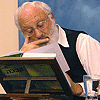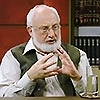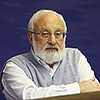Audio Version Of The Blog – 1/12/23
Listen to an Audio Version of the Blog
Download:MP3 Audio

Listen to an Audio Version of the Blog
Download:MP3 Audio
 Question: Time is usually represented as a river flowing in one direction. Some argue that time is like rain that consists of individual drops. And then our whole life looks like a set of individual frames, like a movie. How do you imagine time?
Question: Time is usually represented as a river flowing in one direction. Some argue that time is like rain that consists of individual drops. And then our whole life looks like a set of individual frames, like a movie. How do you imagine time?
Answer: I do not imagine time; I imagine actions. For people who measure themselves by the actions they perform, time flows in a completely different way, on a different scale than for others.
Comment: If I understand correctly, time flows in the material world regardless of whether our states change or not, i.e., regardless of us.
My Response: Relative to whom does time change? Relative to me. Does my neighbor live in the same time as me or not? Or does he have a completely different scale? Therefore, it is all subjective.
We live by a mechanical clock by which we measure ourselves. But how this hour passes for him and for me, I do not know.
Question: If a Kabbalist himself consciously changes his states—hastens them, slows them down—then does he control time?
Answer: He controls time according to his connection with the Creator or his distancing from Him.
[307366]
From KabTV’s “Spiritual States” 12/25/22
Related Material:
Ascending Above Time
Transcending Time And Distance
Master Of Time
 Question: Maybe we cannot create a time machine because our protein world is illusory and exists only in our imagination?
Question: Maybe we cannot create a time machine because our protein world is illusory and exists only in our imagination?
Answer: It exists in you in such a way that you are now sitting in front of the camera and talking to me. And there are ten billion people around you, and so on, and so on. In principle, this is all, of course, your world.
This is what appears to you. I also exist in this world of yours. And I also imagine myself existing in some kind of my own world.
Kabbalists write that in the future all people will unite into one single humankind and become like one organism in their feelings. In this state, time will vanish.
If no one feels like a single person but only as the totality of all mankind, then no one from the future will come to you because there will be no such state when we represent individual people. All of us together will become one person called Adam.
And then, as it is written in Kabbalah, material reality will disappear from our senses because we will not feel disconnected from each other, but we will begin to exist in one common spiritual body.
Therefore, we do not need to create a time machine to soar into the future because it exists in a completely different degree.
[307507]
From KabTV’s “Spiritual states” 12/25/22
Related Material:
The Path Of The Future Correction Is For All
Looking At The Future Together With A Kabbalist
You Will Not Learn Without Trying
 Question: What is the major difference between the Torah and The Book of Zohar?
Question: What is the major difference between the Torah and The Book of Zohar?
Answer: It is only in the style, form of presentation, and absoluteness of the Torah. What is written in it is absolute. There are a lot of expressions in The Book of Zohar that can be misinterpreted.
The Zohar is generally incomplete in itself. Initially, it included about thirty volumes. To date only a small part of it has been found, which means, it is incomplete, fragmentary and cannot claim to be like the Torah.
But in terms of the power of its presentation, The Zohar affects us much more than the Torah.
[307504]
From KabTV’s “I Got a Call. The Zohar against the Torah” 1/21/12
Related Material:
The Connection Between The Torah And The Book Of Zohar
The Structure Of The Book Of Zohar
Zohar, Commentary On The Torah
 A prayer of many rises before the Creator, and the Creator crowns Himself with that prayer since it rises in several ways. This is because one asks for Hassadim, the other for Gevurot, and a third for Rachamim. And it consists of several sides: the right side, the left, and the middle.
A prayer of many rises before the Creator, and the Creator crowns Himself with that prayer since it rises in several ways. This is because one asks for Hassadim, the other for Gevurot, and a third for Rachamim. And it consists of several sides: the right side, the left, and the middle.
But a prayer of one does not comprise all the sides; it is only on one way. Either one asks for Hassadim or Gevurot or Rachamim.
Hence, a prayer of one is not erected to be received like the prayer of many, as it does not include all three lines like the prayer of many (Zohar for All, “VaYishlach,” Item 45).
In order to come to the common prayer, a prayer for all as one whole, to become one, it is necessary to go through very difficult states of inner scrutiny and to understand that:
1. The spiritual goal is more important than all other goals.
2. It is impossible to reach it alone but only by creating one common yearning from individual yearnings, and then it will be similar to the Creator and the upper light will fill it.
Therefore, only such a request, such a prayer, can be heard, meaning it can cause the corrective action of the upper light.
Reading The Book of Zohar causes us to understand that we must be together because without exiting ourselves it is impossible to reach bestowal, the qualities of the Creator, to exist in the upper world.
It is said: “From the love for the created beings to the love for the Creator.” The Creator gave us the illusion that there are many people around us, and we must destroy this illusion, understand that all this is inside of me, and ask Him to unite the whole world within me.
Then the prayer of many will turn into a true prayer of one.
[7028]
From the Daily Kabbalah Lesson 12/20/09, The Book of Zohar
Related Material:
The Prayer Of Many
The Prayer Of Many – A Single Demand
Whom Do We Pray For?
 The upper expects only a reaction from us. Portions of light come from the upper to the lower (to each of us), and require us to respond correctly. The upper knows exactly what is happening to the lower one, what state the lower one is in, because He forms this state for him.
The upper expects only a reaction from us. Portions of light come from the upper to the lower (to each of us), and require us to respond correctly. The upper knows exactly what is happening to the lower one, what state the lower one is in, because He forms this state for him.
Of course, the upper one knows what the lower one is ready for. He arranges for him all the external and internal conditions for free choice and leaves to the lowest only one thing incomprehensible and unknown to the lower—the middle third of Tifferet (Klipat Noga). It is in this state that the lower one must form the middle line himself.
If the lower one, in response to the influence of the upper one, correctly builds the middle line, it means that he has been awarded. Then he really inclined himself and the whole world (the whole environment that the upper formed for him at that moment) to good.
Therefore, all that is required of the lower, when he feels a lack (Hisaron), is to turn to the upper and get the component that he lacks from Him in order to incline himself and the whole world to good.
After all, the lowest lacks knowledge, sensation, and then the ability to decide. He must receive all this from the upper.
The upper one leaves him a Klipat Noga so that the lower one wishes to turn to Him and get what he lacks. If the lower one is ready to receive this filing for the Klipat Noga, then he receives it, and this is the additional force of bestowal that he acquires at the current degree, and due to it rises to the next degree.
[29815]
From the 2nd part of the Daily Kabbalah Lesson 12/10/10, The Book of Zohar “Tzav (Command)”
Related Material:
Where Lawlessness Rules
I Choose But I Do Not Rule
Revealing The Words Of The Zohar
 Question: How do you feel how far your student has progressed?
Question: How do you feel how far your student has progressed?
Answer: I conduct an analysis and see. The analysis is not of medical indicators, but of the spirit.
The spiritual is the same material, but not for everyone. For example, you can do an analysis of various waves, radioactivity, gasses, or some other natural phenomena, and I can measure the parameters of the spirit, and the other cannot.
Question: But how is this measured? Due to the fact that a person does some certain actions, or does he have internal changes after all?
Answer: Of course internal changes are taking place in him. I incorporate him in myself, as if in my laboratory, and measure using my ruler. Previously, he got, say, up to 20 divisions, and now up to 25.
[307394]
From KabTV’s “I Got a Call. Proper Self-analysis” 1/21/12
Related Material:
Contact In A Force Field
A Lesson As Change Of States
Belonging To One Spiritual Organ
 Michael Laitman, On Quora: “Do people see others as a mirror of themselves?“
Michael Laitman, On Quora: “Do people see others as a mirror of themselves?“
Undoubtedly, we see people not for who they are. Also, it is not just people, but anything we see, we seemingly bring it to life according to what we want to see in it. People in and of themselves do not exist, but we see people according to what we want to see in them.
What does it mean that we want to see something in someone?
So many people in our lives simply pass us by, as if they do not stand out from the background. However, to the extent in which we get to know certain people, then we gain some kind of impression of them.
We then relate to them in a certain way. Then, even before we start communicating with them, we already picture their image in us based on our previous impressions that we accumulated. We register various impressions from people the more we encounter them. Therefore, we do not know any people for who they are. We only know these images that we sculpt within us.

Based on the video “You Don’t See People for Who They Are” with Kabbalist Dr. Michael Laitman, Tal Mandelbaum and Oren Levi. Written/edited by students of Kabbalist Dr. Michael Laitman.
Preparation to the Lesson
| [media 1] | [media 2] |
Zohar for All “Introduction to The Book of Zohar,” “The Donkey Driver,” Item 101
| [media 3] | [media 4] |
Writings of Baal HaSulam “Introduction to The Book of Zohar,” Item 39
| [media 5] | [media 6] |
Selected Highlights
| [media 7] | [media 8] |